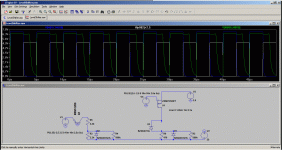Disclaimer: all this is, momentarily, LTspice-only 😀 So no real-world prototypes made just yet...
Long story short: small-scale UcD-type amp, D-pak output FETs, IRS2011 gate driver, dead-time generation using four XOR gates, LM311 input comparator.
Input stage (LM311 & 74HC86) supplied with +/-2.5v, power section +/-25v.
Task: shifting the outputs of the XOR gates (Lo = -2.5v, Hi = +2.5v) to -25v-referenced level, while observing the recommended Hi input level of 5.5v for the IRS2011.
Restrictions: XOR gates have a max +/-12mA output current, so a common-base PNP is pretty much out (resistor values need to be too low, to get any decent switching times), so perhaps a P-FET might work best.
Issue: fall-time of the gate driver inputs (Hi-to-Lo) is a bit sluggish, which leads to the need of greater dead-time 🙄
I'm attaching a screenshot from LTspice with a comparison between the common-base level-shifter (green trace) and the P-FET version (blue trace). White trace is the input square-wave. I used those 6.2v zeners "to be on the safe side", gate-driver input-voltage-wise.
I'd really appreciate some thoughts on this. In an ideal world, it'd be nice to be able to find a solution that would scale reasonably well with slightly greater output voltages too 🙂
Best regards,
Chris
Long story short: small-scale UcD-type amp, D-pak output FETs, IRS2011 gate driver, dead-time generation using four XOR gates, LM311 input comparator.
Input stage (LM311 & 74HC86) supplied with +/-2.5v, power section +/-25v.
Task: shifting the outputs of the XOR gates (Lo = -2.5v, Hi = +2.5v) to -25v-referenced level, while observing the recommended Hi input level of 5.5v for the IRS2011.
Restrictions: XOR gates have a max +/-12mA output current, so a common-base PNP is pretty much out (resistor values need to be too low, to get any decent switching times), so perhaps a P-FET might work best.
Issue: fall-time of the gate driver inputs (Hi-to-Lo) is a bit sluggish, which leads to the need of greater dead-time 🙄
I'm attaching a screenshot from LTspice with a comparison between the common-base level-shifter (green trace) and the P-FET version (blue trace). White trace is the input square-wave. I used those 6.2v zeners "to be on the safe side", gate-driver input-voltage-wise.
I'd really appreciate some thoughts on this. In an ideal world, it'd be nice to be able to find a solution that would scale reasonably well with slightly greater output voltages too 🙂
Best regards,
Chris
Attachments
Last edited:
...if done right, the common base arrangement will show a propagation delay of a few tens of ns and sloping times about 50ns, or even less.
1. Put at resistor between V1 and the emitter of Q1, in order to control the current, without driving Q1 into saturation. Something like 270 Ohms should be fine. ==> approx. 7mA
2. You do not need R5 anymore, except for heat sharing. A solid wire is fine.
3. Change R3 to 680 Ohms.
4. Kick out the zener D2. Zeners have high capacitances which slow down the sloping. If you want to clamp the voltage, then clamp it with a 1N4148 against a 5V auxiliary standing of from the neg rail.
5. No need to choose high current low saturation BJTs. Normal small signal BJTs will do the job.
6. If you go to higher voltages, then types like the 2N5401 are fine, but then you should use R5 again in order to get a heat sharing. When staying with 7mA like proposed above put R5=(Vrail-20V)/0.007A
7. Search the forum. It's really not a secret.
1. Put at resistor between V1 and the emitter of Q1, in order to control the current, without driving Q1 into saturation. Something like 270 Ohms should be fine. ==> approx. 7mA
2. You do not need R5 anymore, except for heat sharing. A solid wire is fine.
3. Change R3 to 680 Ohms.
4. Kick out the zener D2. Zeners have high capacitances which slow down the sloping. If you want to clamp the voltage, then clamp it with a 1N4148 against a 5V auxiliary standing of from the neg rail.
5. No need to choose high current low saturation BJTs. Normal small signal BJTs will do the job.
6. If you go to higher voltages, then types like the 2N5401 are fine, but then you should use R5 again in order to get a heat sharing. When staying with 7mA like proposed above put R5=(Vrail-20V)/0.007A
7. Search the forum. It's really not a secret.
I had tried a bunch of different arrangements, but i never considered an emitter resistor 
Thank you ever so much! 😀 Works like a charm now 🙂 Can't wait to get prototyping...

Thank you ever so much! 😀 Works like a charm now 🙂 Can't wait to get prototyping...
- Status
- Not open for further replies.
